Turbo Choice For A 32 Gtr
Announcements
-
Similar Content
-
Latest Posts
-
Sorry I didn’t explain myself properly, by free revving I meant if I just floor it, it gets to 7kish and will start to break up/not hit limiter properly, off boost I’ve driven the car until near on empty. I have a fuel pressure gauge mounted in the engine bay, holds fuel pressure consistently full tank or half tank even when revving, and no the pump sound doesn't change. all the fuel lines inside the tank are fairly new but will look into it, could that also be an issue with the lines outside the tank ?
-
Yeah maybe I got a bad batch that only lasted 6 years. Or conversely maybe I got a good batch that managed to last 6 years. Either way I have sourced a set of OEM hub/bearing assemblies so I keep hearing! Even from life long mechanics. Apparently this failure is unheard of…
-
By Dose Pipe Sutututu · Posted
I am trying to understand how that even happened to the hub... wtf -
Hell, I'm sufficiently wary of the ZSS suspension arms, let alone something like a hub.
-
Got it back home and got started pulling the hub off and diagnose the issue. Axle was stuck after removing the 36mm nut so i used a 3 jaw puller to try and push it out and... eH5FXvJ8.mp4 spend the next few hours trying to remove the axle from the remaining hub as it was very much jammed in there when the spindle sheared off. resulting damage as below R53AIy6 - Imgur.mp4 Looks like the was already a stress fracturing in the spindle as can be seen with the darker cracked section My working theory is maybe when the pinion gear exploded last year the shock put through the hub was the initial crack. Then a few events later it finally let go. Just lucky it happened where it did and not 190km/h on the next sweeper or into the hairpin The bearing/hub assembly went in in 2019 and were non-genuine "ZSS" assemblies and no nails were harmed in the process. #BreakHubsNotNails
-






Recommended Posts
Create an account or sign in to comment
You need to be a member in order to leave a comment
Create an account
Sign up for a new account in our community. It's easy!
Register a new accountSign in
Already have an account? Sign in here.
Sign In Now